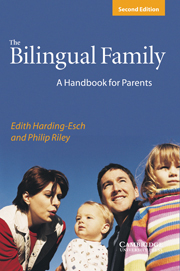Preface
Published online by Cambridge University Press: 29 March 2010
Summary
This is a handbook for all parents who might be considering bringing up their children as bilinguals. It is written for the English-speaking family living in Stuttgart, or Madrid or Strasbourg, the Spanish woman who has settled in Germany or the Danish family who live in North America. It is not about bilingual societies: we will not talk about the distribution of speakers of different languages in countries such as Finland or Wales. The linguistic problems of immigrant groups are not discussed either: they involve social and political issues that go well beyond the scope of this book.
Although a majority of our examples concern European families, what we have to say will also be relevant to parents in many other parts of the world. In the same way, although many, but not all, of our case studies refer to professional families, we believe that the book should be useful to the wider range of increasingly mobile families who are faced with the problem of educating their children in two or more languages. What we have aimed at here is to help, inform and reassure parents by making available to them the experiences of a number of other families. The term ‘family’ refers to the social unit formed by any parent(s) plus children.
We have no particular theoretical or psychological axe to grind: this is not a set of dogmatic, hard and fast rules, but rather a practical discussion of some of the basic issues that we hope will help parents in their own particular situation.
- Type
- Chapter
- Information
- The Bilingual FamilyA Handbook for Parents, pp. xiii - xviPublisher: Cambridge University PressPrint publication year: 2003



